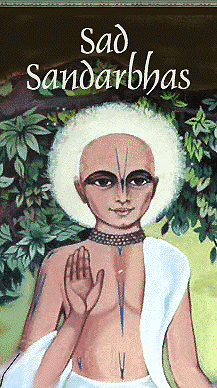
BY: SUN STAFF
Jan 16, CANADA (SUN) —
Tattva Sandarbha
by Srila Jiva Goswami
SECTION FIFTY
Hereafter, to determine the detailed import of Srimad Bhagavatam, as has been discussed, sambandha, abhidheya, and prayojana will be explained in order in these six sandarbhas. Out of these six, Tattva-Sandarbha explains the sambandha (relation) between Vacya and Vacaka--the subject and the medium used.
Srila Vyasadeva indicates this subject in a general manner in the second Bhagavatam verse (1.1.2) with the words, "The Absolute Truth is to be known here (in the Srimad Bhagavatam)..."
While commenting on this part of the verse Sridhara Svami writes:
Here, in this beautiful Bhagavatam, the Absolute Reality in its highest manifestation is to be known, and not in the form of substance, qualities and so on as assumed by the Vaiseshikas etc.
Sri Jiva Toshani Commentary
Srila Jiva Gosvami here informs us that the same sambandha, abhidheya, and prayojana tattvas that Vyasadeva and Sukadeva Gosvami realized will be explained in greater detail in the six Sandarbhas. These were briefly mentioned in Anucchedas Eight and Nine, now he will expand his explanation of all three. Naturally, the basis of his presentation will be the Srimad Bhagavatam. The Tattva, Bhagavat, Paramatma, and Krishna Sandarbhas deal with the sambanda tattva. Bhakti Sandarbha deals with abhidheya tattva and Priti Sandarbha with the prayojana tattva.
Tattva Sandarbha serves as an introduction in that it explains the overall subject established through the Shat Sandarbhas. Technically this relationship is called the vacya-vacakata sambandha, or the relation of the subject with the words of the book. The subject is stated in the second verse of the Bhagavatam, vedyam vastvamatra vastu "Absolute Reality is to be understood herein..." As discussed earlier there are various levels of manifestation of reality, but Srimad Bhagavatam gives knowledge about the one Absolute Reality, Sri Krishna, who encompasses and reconciles all other realities.
Sages like Kanada and Gautama based their philosophies on a certain number of elements or realities. They say that by knowing these elements properly one can become free from material miseries. For example the vaiseshika philosophy, mentioned at the end of this annucheda, has seven elements--Dravya (substance), Guna (Quality), Karma (action), Samanya (generality), visesha (particularity), samavaya (Inherence) and Abhava (non-existence). The vaiseshikas try to explain the whole cosmos by these seven elements. Though it is true that an understanding of these elements leads to realization of a certain level of reality, that does not compare with the Absolute Reality, which is the sole subject of Srimad Bhagavatam. The nature of this reality is explained in the next section.
Go to Section Fifty-one
Return to Section Forty-nine
